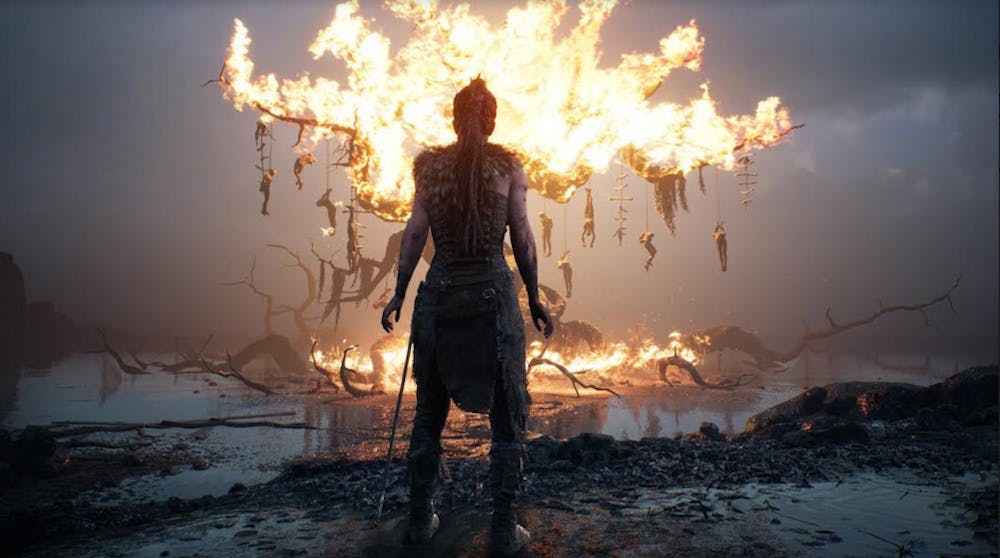Game: "Hellblade: "Senua’s Sacrifice"
Release Date: Aug. 8
Platforms: PS4, PC
Developer: Ninja Theory
Grade: B
If you saw the trailers for “Hellblade: Senua’s Sacrifice,” you would be forgiven for thinking it was a God of War-like hack and slash game set in Norse mythology. The design of the characters as well as the developer Ninja Theory’s past point towards this type of gameplay. In any case, it’s very unlikely that anyone could have seen a trailer and figured out what the game truly was: a harrowing story-based experience that shows the trauma and struggles of mental illness in gruesome and moving ways.
In “Hellblade,” you play as a Celtic warrior named Senua who suffers from a severe mental illness. Senua’s main driving force throughout the game is to save the soul of a man from her past named Dillion. To do this she has to travel to a foreign land and into the depths of Helheim, the Norse version of Hell.
The game tells you right away that for the best experience you will need over-ear headphones, and it immediately becomes clear why this is the case. Throughout the entire game you hear multiple voices that exist inside Senua’s head, and with headphones on, you get the sensation of different voices actually whispering in your ears. This plus the fact that the entire game operates with binaural sounds, “Hellblade” is easily one of the most immersive games I’ve ever played. Having Senua’s voices whispering and sometimes shouting or arguing with each other in my ears is a wild experience and frankly I believe that if you don’t wear headphones for this game you will truly be missing out.
The very first credit you see when you play “Hellblade” is for Paul Fletcher, the game’s mental health adviser, and this is very indicative of Ninja Theory’s priority in making this game. While “Hellblade” does have a fair amount of combat and puzzles, they aren’t the main focus nor are they where the games shines. Instead, where “Hellblade” leaves its impression is through its mysterious and unsettling atmosphere, strong storytelling and deep look into what it’s like living with psychosis. As you travel through the game’s many stunning set pieces, you see everything from Senua’s often distorted and unreliable perspective. It is often hard to decipher if what you’re seeing is real or a creation Senua has made in her own head that connects to her tragic past or deep fears. This makes for a story that is strange, dark and impossible to stop thinking about.
However, for a game with such an impactful narrative and tone, “Hellblade” can get pretty tedious. As I said before, “Hellblade’s” combat and puzzles aren’t where the game shines, and in fact they can both take away from the game’s enjoyment at times. The game’s fighting is fairly basic with the standard dodge, block, light attack and strong attack and the only additional power you learn is one that can slow enemies for a short time. This is fine in the early game as the player gets used to the pace of battle and the different enemies that are thrown their way. The problem is that this never changes.
As the game progresses, instead of adding new elements to combat to make it harder and more interesting, Ninja Theory opted to just increase the number of opponents to sometimes absurd amounts. There were multiple times where I started to wonder if I was supposed to be doing something different to end the endless horde of demonic warriors coming at me only to finally kill the last one and then proceed to rub my painful fingers that were tired of the button-mashing. By the end of the game, I started to dread combat sections as they felt unnecessary and honestly stopped being fun.
The other half of "Hellblade’s" gameplay identity is its puzzles and while these are certainly better than the combat, they still start to overstay their welcome by the end. The majority of "Hellblade" is spent solving puzzles in the environment in order to progress and while there is some variety in the puzzles, many of them are repeated too many times and, much like the combat, began to come across as tedious, especially as the story became more and more interesting.
As a full package, these two pillars of “Hellblade’s” gameplay are a bit disappointing, however there are incredible moments that, in my opinion, make up for the game’s flaws. Without spoiling anything, there are a few sections around the halfway point of “Hellblade” that use audio and visual cues in a way that I have never seen a game even come close to matching. The way that I continue to think about the impressive and unique tools that this game used to invoke fear, sadness, confusion and awe in me made up for the frustration I felt, even if it only did so narrowly.
“Hellblade” is a tough game to form a cohesive opinion on as it’s simultaneously intriguing, innovative and irritating. Overall, especially because of its $30 price, “Hellblade” is undoubtedly an experience worth having, under a few conditions. If you are wanting a sharp hack and slash game or even a genre pushing puzzle game, “Hellblade” isn’t going to satisfy those needs. However, if you are patient and you want a new type of gameplay experience and are interested in being told a fascinating story surrounding a multi-layered protagonist, “Hellblade” just might be one of your favorite games in a while.

